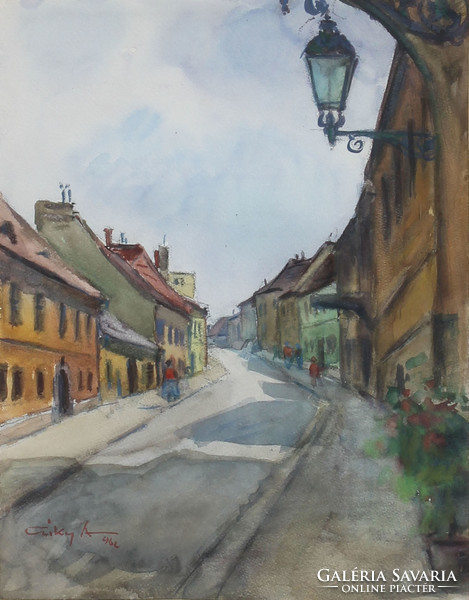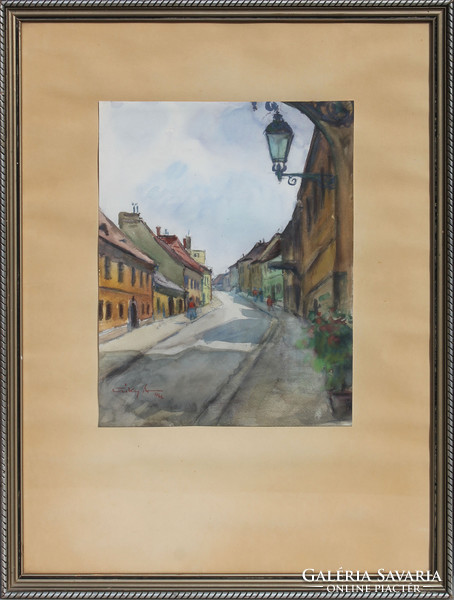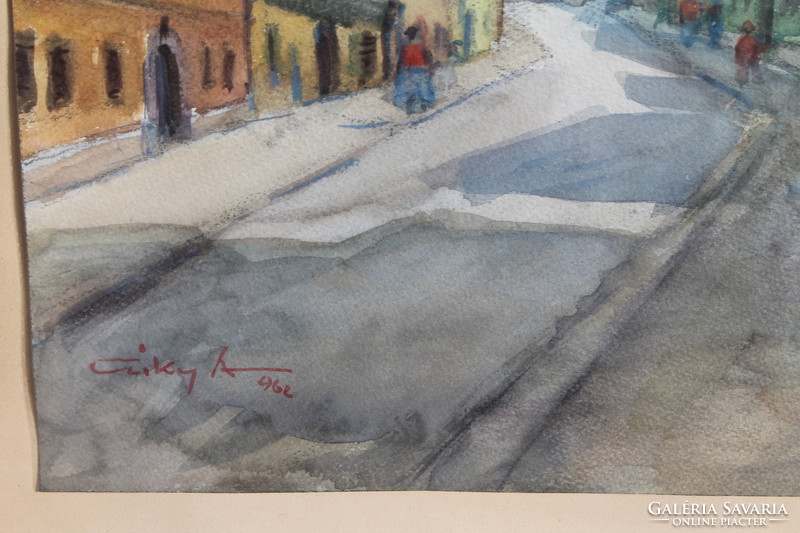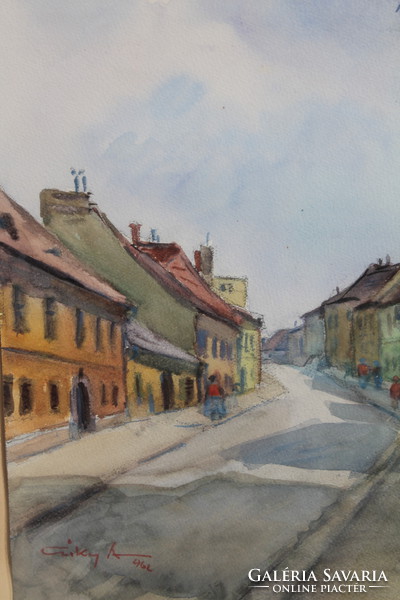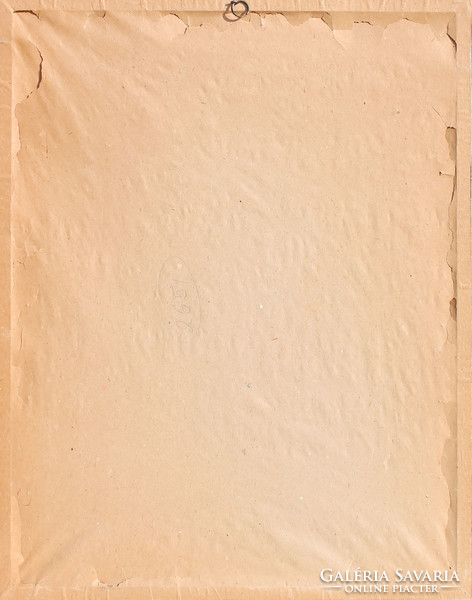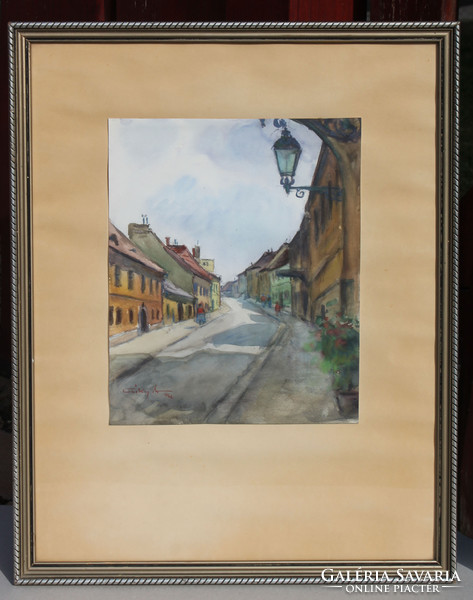András Csiky: street in the castle
The sale expires on May. 23, 23:35.
39.920 HUF 110.88 USD
| Listed: May 08, 2024 |
| Item code: 5163909 |
| Views: 270 |
| Watchers: 1 |
| Offers: 0 offers |
dexter72 (693)
![]() Békés county
Békés county
Learn more about the actions to make our online marketplace more secure and convenient. Details
| Subject: | streetscape |
| Painting surface: | paper |
| Style: | post-impressionism |
| Age: | 1950-1969 |
| Signature: | signed |
| Condition: | flawless |
| Money-back guarantee on originality: | yes |
| Originality: | original |
| Originality confirmed by expert?: | yes |
András Csiky (zilah, 1894 - Budapest, 1971): street in the castle (1962)
Watercolor, paper 32 x 26 cm, marking left-middle below: csiky a 962
In its original frame, behind glass, it can be hung immediately on the wall! The size of the picture with a frame is 57.5 x 45.5 cm
It can be placed in homes with traditional and minimal art furnishings! We deliver by Mpl courier, we pack excellent.
Biography: his father is a dr. Csiky l. John. His mother was a Verzar rose, also from a noble Armenian family. Andrew was the firstborn of a family of ten children. Eight of them were alive by 1971.
Shortly after his birth, his parents moved to the county of Uzhgorod, where his father got a job as a general practitioner. He went to elementary school here. He graduated from the Hungarian Royal State Grammar School in Erzsébetváros, where he graduated in 1912. In the 1913/14 academic year he was a student of the National Royal Hungarian College of Fine Arts in Budapest, majoring in drawing teaching.
On October 17, 1915, he received a military call to the Royal Hungarian Infantry Regiment No. 24. He was soon taken to the Galician front, where on April 14, 1918, he became a reserve army prince, later as a deputy commander of the army prod with a Charles cross, and then as a ensign in Russian and later Soviet captivity. Yekaterinburg, Krasnoyarsk, Petrograd, Riga were places of detention. He immortalized the memories of his captivity on pencil sketches. In order to make money, he made a model of an Orthodox church in Krasnoyarsk from matchsticks, which soon found a host. He and his prisoners organized amateur color performances, which were attended by spectators from the city. For this he made invitations and posters in German. His escape attempts were unsuccessful. He was released from captivity on October 20, 1921.
When he returned home, early, on July 18, 1921, his father, who had died, was no longer alive. It also meant for him that he could no longer pursue his college studies in the fine arts. In order to make a living, he mastered the profession of a photographer at the Guards in Cluj-Napoca and, with the support of his uncles, opened a photography studio in Turda. He sought to carry out his photographic work at an artistic level. His achievements are attested by diplomas and newspaper publications obtained between 1929 and 1941.
In addition to his studio work, he painted landscapes and still lifes with watercolors, sometimes with oil. What was seen on excursions around Torda and Transylvania formed the fresh themes of his landscapes. After the decision in Vienna in 1940, in September of that year he closed his studio in Turda, moved temporarily to Cluj-Napoca and worked there as an insurance inspector. This forced change caused uncertainty in his usual way of life for some time. In the spring of 1942 he came to Budapest and, after settling in 1944, worked for the mfi-hunnia film factory and mti. He also took on other jobs, but made his living predominantly from photography. He spent all his free time hiking and painting. There was a growing interest in his paintings and recognition in art circles.
He gained a great deal of acquaintance with his pleasant social conduct. He was welcomed into societies. Many memorials testify to this.
The end of World War II reached the territory of Austria, where he was taken prisoner by the Englishman on March 30, 1945, from which he was released in the summer of 1946. However, on arrival at the western railway station, the Hungarian authorities did not allow him to disembark from the train. He had so many opportunities to inform Magda's sister and his brother Louis, with whom he could exchange a few words. He was further taken to Debrecen according to a medical certificate dated 28 August 1946, from where he was again taken prisoner of war. This time he was taken to Latvia, Valga. There are also many pencil sketches of this latter captivity.
He arrived home from Budapest on August 30, 1947, from captivity. He undertook decorative work to earn a living and retire, but also earned an income from the sale of his paintings.
There has been a growing interest in his fresh, excellent landscapes and tastefully well-composed still lifes. Aside from a few oil, crayon, and tempera paintings, he painted his paintings predominantly in watercolor. In the latter, he acquired an excellent brush handling technique. His pictures were taken extremely quickly. He worked tirelessly regardless of his living conditions and weather conditions.
In the second half of the 1950s, he was featured in three exhibitions at the art gallery, where they were sold out.
Between 1956 and 1958, he was a member of the new Fine Arts Working Community. His pictures were judged and sold here. After the dissolution of the working community, he joined the Fine Arts Fund, with which his relationship was initially acceptable. Some of his paintings were sold, three of his watercolors were bought, and copies of them were distributed as pictorial postcards. Later, this connection was not cloudless.
His pictures can be found in many Hungarian families, but many of them went abroad: to Transylvania, Austria, Germany, Switzerland, France, Sweden, Croatia, Canada, the USA, Australia, and so on. The number of his images is therefore uncertain, but a good estimate is between 500 and 1,000.
Pictures also remained in the family because it was lovingly gifted at family events.
He died in Budapest on November 16, 1971. The grateful owners, relatives and acquaintances of the pictures lovingly preserve his memory and take care of his grave in the cemetery at Farkasréti.
Compiled by photographer János Tutsek, nephew of András Csiky Budapest, January 22, 2002
Source: http: www.Betonopus.Hu
Please also check out my shop window and other products!
Guarantee conditions
| Guarantee: 1 year |
Payment options
| Wire transfer in advance |
| Cash |
Shipping options
|
Shipping from: Hungary Processing time: 1-2 workdays |
|
| Local pickup | Gyula |
| 2390 HUF | |
| Mail as fragile | 4580 HUF |
